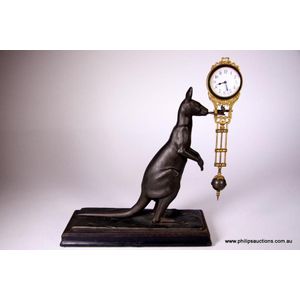Wedgwood Art Deco Kangaroo Figure by John Skeaping
You must be a subscriber, and be logged in to view price and dealer details.
Subscribe Now to view actual auction price for this item
When you subscribe, you have the option of setting the currency in which to display prices to $Au, $US, $NZ or Stg.
- Basalt - Basalt is a hard, dense volcanic rock formed from the rapid cooling of basaltic lava, and makes up most of the earth's oceanic crust.
However it is also the name given by Josiah Wedgwood in 1768 to a fine black unglazed porcelain which he called Wedgwood Black Basalt.
Using this fine-grained stoneware he was able to produce copies of the newly excavated Etruscan pottery from Italy, with a lustrous and smooth, surface, and this new innovation proved to be a huge commercial success. - Art Deco Period - The Art Deco period was a cultural movement that emerged in the 1920s and 1930s, and was characterized by its emphasis on modernism, luxury, and elegance. The name "Art Deco" comes from the Exposition Internationale des Arts Décoratifs et Industriels Modernes, a large exhibition held in Paris in 1925 that showcased the latest trends in decorative arts.
Art Deco was a reaction against the ornate and elaborate styles of the previous era, and reflected a new modern sensibility. It was characterized by streamlined, geometric shapes, bright colours, and the use of new materials such as chrome, glass, and Bakelite. Art Deco designers sought to create a sense of luxury and sophistication, often incorporating expensive materials such as ivory, marble, and rare woods.
Art Deco had a significant impact on a wide range of artistic fields, including architecture, fashion, graphic design, and interior design. Some of the most iconic examples of Art Deco architecture include the Empire State Building in New York City, the Hoover Building in London, and the Palais de Chaillot in Paris.
The Art Deco period came to an end in the 1940s, as World War II and changing cultural trends led to a shift in artistic styles. However, Art Deco remains an important influence on design and art, and continues to be celebrated for its modernist sensibility and glamorous aesthetic. - Dating English Ceramics - Excellent detailed reference books such as Godden's Encyclopaedia of British Pottery and Porcelain Marks will help to identify and date specific manufacturer's marks.
However, there are a few simple guidelines which may also help.
The inclusion of the word 'England' on an item ensured compliance with the American McKinley Tariff Act 1891, which was important for British exporters. An item so marked would have been made after 1891.
In 1921 the act was revised to require the phrase 'Made in' followed by the country. So if an item is marked 'Made in England', it is generally considered to be made after that date, although some manufacturers were using this phrase pior to the act being changed.
The use of the word 'Ltd' of 'Limited' after a company's name indicates a date after 1860, though with ceramic manufacturers this did not become general practice until the 1880's.
This item has been included into following indexes:
- Australian themes, ceramics - kangaroo 202
- Skeaping, John (British) - Wedgwood (England) designers 42
-
Wedgwood (England), item types
- black basalt ware 204
- busts and figurines 121
Visually similar items

John Skeaping Wedgwood Norman Wilson porcelain kangaroo statue, stamped J. Skeaping, Wedgwood, N.W. 23 cm high

A mystery clock with kangaroo motif. c1900's

A cast metal kangaroo mystery clock, 19th century, with movement by Junghans, in the form of a standing kangaroo upon a metal timber plinth, supporting a gilt bronze clock and integral pendulum from a horseshoe shaped mouthpiece, the clock with Arabic nume

Edgar Mansfield, animism sculpture, in bronze issuing from a cast composite base. Height 68 cm
